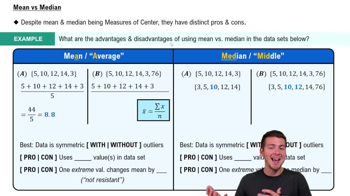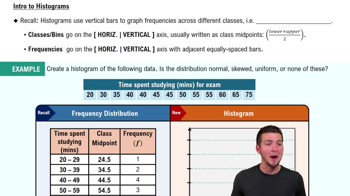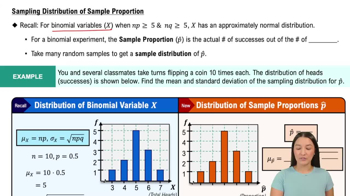Use the frequency histogram below to determine (a) the number of classes and (b) the class width.
Table of contents
- 1. Intro to Stats and Collecting Data1h 14m
- 2. Describing Data with Tables and Graphs1h 55m
- 3. Describing Data Numerically2h 5m
- 4. Probability2h 16m
- 5. Binomial Distribution & Discrete Random Variables3h 6m
- 6. Normal Distribution and Continuous Random Variables2h 11m
- 7. Sampling Distributions & Confidence Intervals: Mean3h 23m
- Sampling Distribution of the Sample Mean and Central Limit Theorem19m
- Distribution of Sample Mean - Excel23m
- Introduction to Confidence Intervals15m
- Confidence Intervals for Population Mean1h 18m
- Determining the Minimum Sample Size Required12m
- Finding Probabilities and T Critical Values - Excel28m
- Confidence Intervals for Population Means - Excel25m
- 8. Sampling Distributions & Confidence Intervals: Proportion1h 12m
- 9. Hypothesis Testing for One Sample3h 29m
- 10. Hypothesis Testing for Two Samples4h 50m
- Two Proportions1h 13m
- Two Proportions Hypothesis Test - Excel28m
- Two Means - Unknown, Unequal Variance1h 3m
- Two Means - Unknown Variances Hypothesis Test - Excel12m
- Two Means - Unknown, Equal Variance15m
- Two Means - Unknown, Equal Variances Hypothesis Test - Excel9m
- Two Means - Known Variance12m
- Two Means - Sigma Known Hypothesis Test - Excel21m
- Two Means - Matched Pairs (Dependent Samples)42m
- Matched Pairs Hypothesis Test - Excel12m
- 11. Correlation1h 6m
- 12. Regression1h 50m
- 13. Chi-Square Tests & Goodness of Fit1h 57m
- 14. ANOVA1h 57m
2. Describing Data with Tables and Graphs
Histograms
Problem 2.2.4
Textbook Question
Cell Phone Radiation If we collect a sample of cell phone radiation amounts much larger than the sample included with Exercise 3, and if our sample includes a single outlier, how will that outlier appear in a histogram?
 Verified step by step guidance
Verified step by step guidance1
Understand the concept of an outlier: An outlier is a data point that is significantly different from the other data points in a dataset. It can be much higher or lower than the rest of the data.
Consider the effect of an outlier on a histogram: A histogram is a graphical representation of the distribution of numerical data. It shows the frequency of data points within specified ranges (bins). An outlier will appear as a bar that is separate from the other bars, often at the far end of the histogram.
Visualize the histogram: Imagine the histogram of cell phone radiation amounts. Most data points will cluster around a central range, forming a series of bars. The outlier will be a single bar that is distant from the cluster, indicating its rarity and extremity.
Analyze the impact on the histogram shape: The presence of an outlier can skew the histogram, making it asymmetrical. If the outlier is much larger than the other values, it will extend the range of the histogram, potentially creating a long tail on one side.
Consider the implications for data interpretation: The outlier can affect statistical measures such as the mean and standard deviation, making them less representative of the central tendency of the data. It's important to identify and consider outliers when analyzing data distributions.
 Verified video answer for a similar problem:
Verified video answer for a similar problem:This video solution was recommended by our tutors as helpful for the problem above
Video duration:
2mPlay a video:
Was this helpful?
Key Concepts
Here are the essential concepts you must grasp in order to answer the question correctly.
Outliers
An outlier is a data point that significantly differs from other observations in a dataset. It can skew the results and affect the overall analysis. In a histogram, an outlier will appear as a bar that is isolated from the rest of the data, often at the extreme end of the distribution.
Recommended video:
Guided course

Comparing Mean vs. Median
Histograms
A histogram is a graphical representation of the distribution of numerical data, where data is grouped into bins or intervals. Each bar in a histogram represents the frequency of data points within each bin. It helps in visualizing the shape, spread, and central tendency of the data.
Recommended video:
Guided course

Intro to Histograms
Sample Size
Sample size refers to the number of observations or data points collected in a study. A larger sample size can provide more reliable and accurate estimates of the population parameters. It also affects the visibility and impact of outliers in a histogram, as a larger sample may dilute the effect of an outlier.
Recommended video:

Sampling Distribution of Sample Proportion
Related Videos
Related Practice
Multiple Choice


